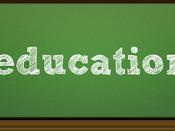Many factors shape educational aims and expectations including gender, racial/ethnic status, family socio-economic status, family structure, parental expectations, religious practice, geographical location and culture (Davis and Pearce, 2007; James, 2002). As individuals partake or belong to an almost infinite array of social discourse, so too there is an almost unlimited interpretation of what is the aim of education, what is important for my son/daughter, the younger generation as a whole or me to know? As individuals we all aspire to learn what we think is important for us in our life. We want to teach our children what we see as the necessary information to achieve or participate in the level of society we ourselves belong or aspire to.
Educational aims from a government perspective are commonly derived principally from the groups with the most influence on the education system. These are mainly members of the upper-middle class in society (Wadham, Pudsey & Boyd, 2007; Mills and Gale, 2002; Connell, 1994; Sizemore, 1979).
These may not be the educational aims that all students aspire too. Individual's social environment, or culture, may place greater emphasis on other areas of learning.
In some societies educational aims might focus on life skills including learning to hunt for food and an understanding of which plants are poisonous. In Australia, many people see the main objective of education as developing numeracy and literacy skills. To others the ability to reason, to doubt, or to see things from others perspectives is more important. Some claim the aim of education is that it should be used to shape children to the norms, values and beliefs of the adult society (Egan, 1999). Others see the aim of education as to continue a social status quo through the continuation of a class system and yet others see the purpose...


